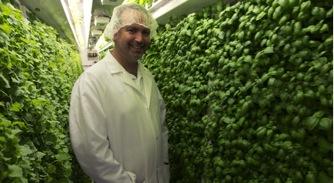
Farming in North Minneapolis? UROC studies the possibility

Some trends come and go, but consumers’ desire to buy fresh, locally produced food seems only to be growing. Farmer’s market sales are booming, traditional grocery stores are stocking more local and regional produce and more and more people are exploring ways to grow healthy food sustainably. One of those people is Dana Anderson, founder of Living Greens Farm (http://www.livinggreensfarm.com/) in Faribault, Minnesota.
Launched in 2012, Living Greens Farm grows plants aeroponically on vertical, space-saving platforms. No growing medium, such as soil or water, is used in the process. Instead, plant roots are open to the air and periodically misted with a nutrient solution. Anderson is proud that the farm’s patent-pending process uses no pesticides or herbicides, as well as 95 percent less water than typical growing methods. And because the process is versatile, the potential is there to grow other things such as fruits, flowers, grasses and more.
In addition to opening an expanded facility in Faribault next summer, Anderson has also partnered with the University of Minnesota Robert J. Jones Urban Research and Outreach Engagement Center (UROC) to explore the feasibility of locating another site in North Minneapolis.
“What traditional farms grow on 200 acres, Living Greens Farm can grow on one,” says Anderson, who for the past couple of years has been talking with UROC’s Northside Job Creation Team (NJCT) about the many gaps in local food production and the need for job creation. Unlike the Faribault operation, which currently grows a variety of leafy greens, such as arugula, basil, micro-greens, kale and more, in 6,000 feet of space, the Minneapolis facility would produce other crops, most likely strawberries and cut flowers.
“Our vision is to continue to expand what we can grow, so we’re talking with the city of Minneapolis and the University about how to do that,” Anderson explains.
So far, UROC has produced two reports for Living Greens Farm, one on the feasibility of opening a Northside location, and the other assessing how the company should approach the manufacturing process moving forward. “Both reports were first class, and I’ve been blown away by how bright the students we’ve worked with are,” says Anderson, who envisions Living Greens Farm eventually doing business worldwide.
UROC’s Northside Job Creation Team is a collaborative effort with many different partners, including several departments at the University, the city of Minneapolis, Northside Funders Groups, Minneapolis Foundation, Minneapolis Urban League, Pillsbury United Communities, local business and faith communities, the Carlson School of Management’s Carlson Consulting Enterprise and others. It was started in 2012 in response to Minnesota Governor Mark Dayton’s promise to do something to boost job creation in North Minneapolis. The goal is to attract 1,000 living-wage jobs to the Northside by 2019.
“Living Greens Farm is on the cutting edge of aeroponics technology, and we’re really excited that they’re considering North Minneapolis for a second location” says James De Sota, UROC’s director of administration and projects. “If we can have a major player in the aeroponics industry to open a location in North Minneapolis, that will set the stage for a lot of good things to happen around job creation and economic vitality.”